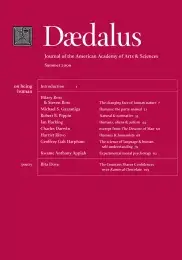Introduction
The essays in this volume examine some of the ways that we, in the first decade of the twenty-first century, understand what it means to be human. It is a question that involves us, necessarily, in the traditional concerns of world religions and of the disciplines we call “the humanities.” Increasingly, it is also a driving question behind important scientific research.
Human distinctness has always been an implicit subject of scientific inquiry; today’s scientists address the question explicitly. With an extraordinary range of conceptual instruments, technologies, and methodologies, they investigate issues that Socrates once examined in philosophical dialogue, Shakespeare in dramatic verse, and Michelangelo in paint and marble. Geneticists, neuroscientists, and psychologists now join philosophers, poets, and artists in seeking a more adequate description of humanness. The results of this quest can be both exhilarating and dizzying as we strive to integrate multiple perspectives.
In 2006, the National Humanities Center launched a three-year study of how advances in science are enlarging the terms through which human life is discussed, and continuing to disturb traditional understandings of what it means to be human. The essays gathered here constitute a sampling of the scholarship inspired by the Center’s effort. This issue also marks the Center’s thirtieth anniversary.
One of the world’s leading institutes for advanced research in the humanities, the National Humanities Center was founded by the American Academy of Arts and Sciences in 1978. In the late 1960s, two distinguished literary scholars, Meyer Abrams of Cornell and Morton Bloomfield of Harvard, and philosopher Gregory Vlastos of Princeton spent a year together at the Center for Advanced Study in the Behavioral Sciences, where they found themselves “three humanists in a sea of social scientists.” They proposed the creation of a similar institution for the humanities, to encourage excellence in scholarship and to ensure the continuing strength of the liberal arts in American life.
John Voss, then Executive Officer of the American Academy, recognized the importance of the idea and invited literary scholar Steven Marcus of Columbia University to serve as project director. Beginning with a small grant of $2,500 from the Academy’s own research funds, Voss and Marcus organized a planning committee that included sociologist Daniel Bell, philosophers Frederick Burkhardt and Charles Frankel, classicist and president of Princeton University Robert Goheen, and literary critic Lionel Trilling, among others. Initial grants from the Rockefeller, Ford, Carnegie, and Andrew W. Mellon Foundations, as well as from the National Endowment for the Humanities, enabled the planning committee to develop the goals of the Center and create its new home. Groundbreaking for the Center – in Research Triangle Park, North Carolina – took place in fall 1976, and the first group of scholars arrived in 1978. Thirty years later, the Center thrives as a home for national programs, research, and publications on the humanities.
The Academy is proud of its role as principal catalyst in the establishment of the National Humanities Center; our representatives continue to serve on its board, and several of our directors take an active role in its activities. We are pleased to celebrate its anniversary with this issue of Daedalus.
